高中英语Unit2PoemsReadingAfewsimpleformsofEnglishpoems课件新人教版选修6
- 格式:ppt
- 大小:1.13 MB
- 文档页数:35


Unit 2 A FEW SIMPLE FORMS OF ENGLISH POEMSStep I: Read and remember the following wordspoet(s) 诗人rhyme n. 韵脚(c)poem(s) 诗歌vi. 押韵poetry 诗歌总称,不可数rhythm n. 节奏,韵律Step II: Feel the beauty of poems(1)Summer 夏天Sleepy, salty 困乏,咸涩Drying, drooping, dreading 干涸,枯萎,恐怖Week in, week out 周而复始Endless 永无止境(2)面朝大海,春暖花开海子从明天起,做一个幸福的人From tomorrow on, I will be a happy man;喂马,劈柴,周游世界Grooming, chopping, and traveling all over the world.从明天起,关心粮食和蔬菜From tomorrow on, I will care foodstuff and vegetables,我有一所房子,面朝大海,春暖花开I have a house, towards the sea, with spring flowers blossoming.从明天起,和每一个亲人通信From tomorrow on, I will write to each of my dear ones,告诉他们我的幸福Telling them of my happiness,那幸福的闪电告诉我的What the lightening of blessedness has told me,我将告诉每一个人I will spread it to each of them.给每一条河每一座山取一个温暖的名字And give a warm name for every river and every mountain.陌生人,我也为你祝福Strangers, I will also give you my well-wishing.愿你有一个灿烂的前程May you have a brilliant future!愿你有情人终成眷属May you lovers eventually become spouse!愿你在尘世获得幸福May you enjoy happiness in this earthly world!我只愿面朝大海,春暖花开I only wish to face the sea, with spring flowers blossoming.(3)望夫石唐王健望夫处,江悠悠。
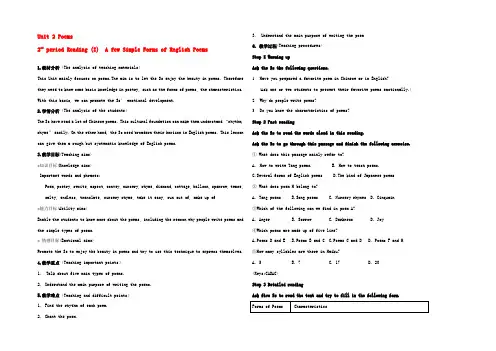
Unit 2 Poems2nd period Reading (I) A few Simple Forms of English Poems1.教材分析(The analysis of teaching materials)This Unit mainly focuses on poems.The aim is to let the Ss enjoy the beauty in poems. Therefore they need to know some basic knowledge in poetry, such as the forms of poems, the characteristics. With this basis, we can promote the Ss’ emotional development.2.学情分析(The analysis of the students)The Ss have read a lot of Chinese poems. This cultural foundation can make them understand “rhythm, rhyme”easily. On the other hand, the Ss need broadern their horizon in English poems. This lesson can give them a rough but systematic knowledge of English poems.3.教学目标(Teaching aims)*知识目标(Knowledge aims)Important words and phrases:Poem, poetry, recite, aspect, convey, nursery, rhyme, diamond, cottage, balloon, sparrow, tease, salty, endless, translate, nursery rhyme, take it easy, run out of, make up of*能力目标(Ability aims)Enable the students to know more about the poems, including the reason why people write poems and the simple types of poems.* 情感目标(Emotional aims)Promote the Ss to enjoy the beauty in poems and try to use this technique to express themselves.4.教学重点(Teaching important points)1.Talk about five main types of poems.2.Understand the main purpose of writing the poems.5.教学难点(Teaching and difficult points)1.Find the rhythm of each poem.2.Chant the poem.3. Understand the main purpose of writing the poem6. 教学过程(Teaching procedures)Step I Warming upAsk the Ss the following questions.1.Have you prepared a favorite poem in Chinese or in English?(Ask one or two students to present their favorite poems emotionally.)2.Why do people write poems?3.Do you know the characteristics of poems?Step 2 Fast readingAsk the Ss to read the words aloud in this reading.Ask the Ss to go through this passage and finish the following exercise.① What does this passage mainly refer to?A.How to write Tang poems.B. How to teach poems.C.Several forms of English poemsD.The kind of Japanese poems② What does poem H belong to?A. Tang poemsB.Song poemsC. Nursery rhymesD. Cinquain③Which of the following can we find in poem A?A. AngerB. SorrowC. DarknessD. Joy④Which poems are made up of five line?A.Poems D and EB.Poems B and CC.Poems C and DD. Poems F and H⑤How many syllables are there in Haiku?A. 5B. 7C. 17D. 20(Keys:CADAC)Step 3 Detailed readingAsk five Ss to read the text and try to fill in the following form.(Keys: 1.imaginative 2.rhythm 3.recite 4.flexible 5.five 6.conveying7.17 8.picuture 9.Creating 10.translated)Step 4 Reading for funListen to the eight poems and try to enjoy them.Poem A: Try to clap the beat and circle the strong rhythm.Poem B&C: Find out the repeated phrasesPoem D—H: Translate themStep 5 SummaryAccording to the functions of poems and contents of the form, summarize this lesson. 7.知识结构(板书设计)8.问题研讨(课堂提问,练习和作业设计)1.课堂提问(questions)①Do you know about some famous poets?②Do you have a favorite poem in Chinese or in English?③Do you know the characteristics of poems?2. 作业(homework)C层: Copy the new words three times for each one and try to be familiar with the pronunciations.AB层:Finish “单词拼写” on p89 on the leaflet.① The source of the river lies in Tibet and its _____(支流) cover much of the country.② We have turned this school into a ____(托儿所).③ The murders all seem to follow a similar _____(模式).④ Don’t get upset. I was only t_____.⑤ The hours of waiting seemed e_____.⑥ They lived in a c_______ in the countryside.。
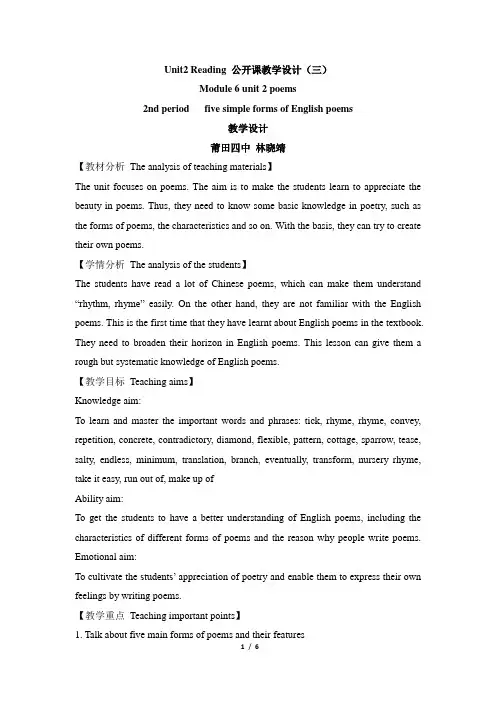
Unit2 Reading 公开课教学设计(三)Module 6 unit 2 poems2nd period five simple forms of English poems教学设计莆田四中林晓靖【教材分析The analysis of teaching materials】The unit focuses on poems. The aim is to make the students learn to appreciate the beauty in poems. Thus, they need to know some basic knowledge in poetry, such as the forms of poems, the characteristics and so on. With the basis, they can try to create their own poems.【学情分析The analysis of the students】The students have read a lot of Chinese poems, which can make them understand “rhythm,rhyme”easily. On the other hand, they are not familiar with the English poems. This is the first time that they have learnt about English poems in the textbook. They need to broaden their horizon in English poems. This lesson can give them a rough but systematic knowledge of English poems.【教学目标Teaching aims】Knowledge aim:To learn and master the important words and phrases: tick, rhyme, rhyme, convey, repetition, concrete, contradictory, diamond, flexible, pattern, cottage, sparrow, tease, salty, endless, minimum, translation, branch, eventually, transform, nursery rhyme, take it easy, run out of, make up ofAbility aim:To get the students to have a better understanding of English poems, including the characteristics of different forms of poems and the reason why people write poems. Emotional aim:To cultivate the students’ appreciation of poetry and enable them to express their own feelings by writing poems.【教学重点Teaching important points】1. Talk about five main forms of poems and their features2. Understand the main purpose of writing poems.【教学难点Teaching difficult points】1. Analysis the features of different forms of poems.2. To enable the students to create their own poems.【教学方法Teaching methods】Discussion and cooperation【教学工具Teaching tools】Multimedia. Chalk and blackboard【教学过程Teaching procedures】Step 1 Lead-in1. Enjoy a nursery rhyme “twinkle” to find some features of nursery rhymes.Q: This is a nursery rhyme. It’s also a form of poems. Do you think it’s easy to learn and recite? Why?A: Nursery rhymes feature in rhyme, repetition, and strong rhythm, through which we can get a feel for the poem’s sound.2. some tips about how to read a poem.get a feel for its sound (esp. rhyme /rhythm/repetition)get a closer understanding of what the poem is trying to convey.(theme)设计说明:这样的导入紧扣主题,通过让学生听并跟唱一首耳熟能详的英文诗,激发学生的求知欲和好奇心,并教会学生应从哪些方面去欣赏诗歌,为下一步的诗歌教学作了很好的铺垫。
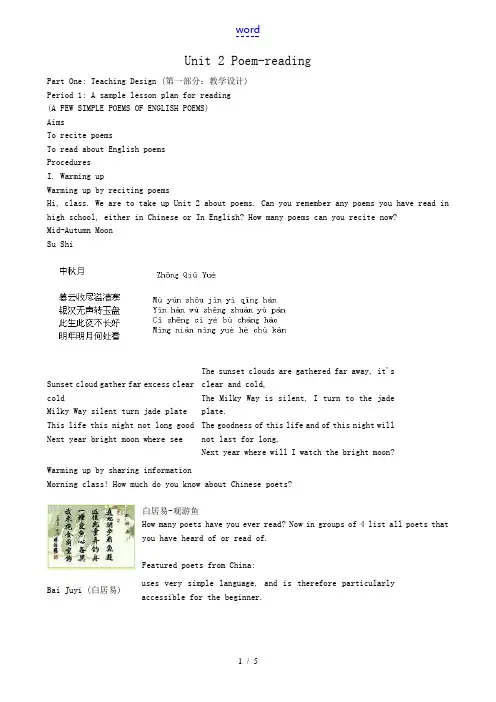
Unit 2 Poem-readingPart One: Teaching Design (第一部分:教学设计)Period 1: A sample lesson plan for reading(A FEW SIMPLE POEMS OF ENGLISH POEMS)AimsTo recite poemsTo read about English poemsProceduresI. Warming upWarming up by reciting poemsHi, class. We are to take up Unit 2 about poems. Can you remember any poems you have read in high school, either in Chinese or In English? How many poems can you recite now?Mid-Autumn MoonSu ShiSunset cloud gather far excess clear coldMilky Way silent turn jade plate This life this night not long good Next year bright moon where see The sunset clouds are gathered far away, it's clear and cold,The Milky Way is silent, I turn to the jade plate.The goodness of this life and of this night will not last for long,Next year where will I watch the bright moon?Warming up by sharing informationMorning class! How much do you know about Chinese poets?白居易-观游鱼How many poets have you ever read? Now in groups of 4 list all poets thatyou have heard of or read of.Featured poets from China:Bai Juyi (白居易) uses very simple language, and is therefore particularly accessible for the beginner.Du Fu (杜甫) widely acknowledged as the finest of the classicalChinese poets. His poems have a particularlysensitive feeling for humanity.Du Mu (杜牧)one of the foremost writers of the late Tang period.Han Yu (韩愈) a founder of Neo-Confucianism as well as a poet,and was exiled for his views.Li Bai (李白) the most popular Chinese poet, with a distinctivelyRomantic style.Li Shangyin (李商隐) wrote verse which was allusive, but which nevertheless dealtwith readily accessible themes of loss and parting.Li Yu (李煜) the last emperor of the Southern Tang dynasty,deposed in 975. His works focus on the memory of lostpleasures.Liu Zongyuan (柳宗元)a Mid-Tang politician and another victim ofpolitical intrigues. Mei Yaochen (梅尧臣) lived in the Song dynasty, and wrote simple, moving poems ofeveryday life and of mourning for his family.Meng Haoran (孟浩然)associated with Wang Wei, and was himself one of the greatestpoets of the High Tang.Ouyang Xiu (欧阳修) one of the pioneers of serious ci poetry in the Song dynasty. A self-taught polymath, his works express a warm,self-deprecatory persona.Su Shi (蘇軾) also known as Su Dongpo, was the most important of the Songdynasty poets. .Tao Qian (陶潛)wrote about his decision to abandon public life and returnto live among nature. He was a major influence on Wang Wei.Wang Wei (王維) one of the three most admired Tang dynasty poets, alongsideDu Fu and Li Bai. A painter as well as a poet, he is knownabove all for his miniaturist celebrations of nature.II. Pre-reading by learning about English poets and their poemsThis is my personal anthology; I hope it will give you, dear classmates great pleasure in reading; perhaps as much as it gave me in (re-)citing the poems from memory. I learned many of these poems by rote 45 years ago as a schoolboy. Schoolchildren nowadays do not learn as much by rote as we did then, so this list is a concentrated essence of excellent poetry for schoolchildren, students of English Literature and poetry-lovers everywhere.The list is sorted alphabetically by the poets' surname. No rankings are given or desired. All of the poems are good, each in its own delectable way.My 31 favourite short English poemsA poem for each day of the month.II. Reading1.Reading aloud to the recordingPoems are written to be read aloud. So first let’s listen and read to the recording of the text. Listen carefully and read correctly.2.Understanding forms of English poemsTo understand poems better we shall talk about forms of poems first.3.Reading and underliningRead the text once again and underline all the expressions useful to you. Copy them in your note book after school as part of homework.4.Reading aloud and translatingTo better understand the feeling expressed, we sometimes translate the poems into Chinese. Try the following one.III. Closing down by doing exercisesTo end our lesson let’s go to page 11 and in groups of four answer the questions in Ex 1 &2. After school you are to turn your oral answers into short paragraphs.。
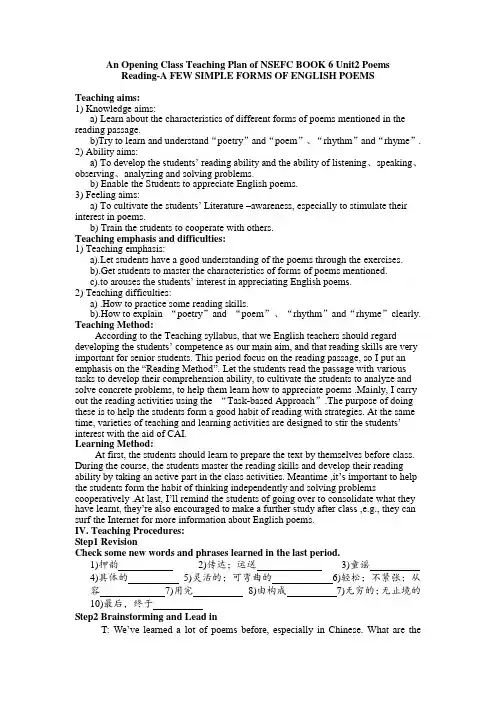
An Opening Class Teaching Plan of NSEFC BOOK 6 Unit2 Poems Reading-A FEW SIMPLE FORMS OF ENGLISH POEMS Teaching aims:1) Knowledge aims:a) Learn about the characteristics of different forms of poems mentioned in the reading passage.b)Try to learn and understand“poetry”and“poem”、“rhythm”and“rhyme”.2) Ability aims:a) To develop the students’ reading ability and the ability of listening、speaking、observing、analyzing and solving problems.b) Enable the Students to appreciate English poems.3) Feeling aims:a) To cultivate the st udents’ Literature –awareness, especially to stimulate their interest in poems.b) Train the students to cooperate with others.Teaching emphasis and difficulties:1) Teaching emphasis:a).Let students have a good understanding of the poems through the exercises.b).Get students to master the characteristics of forms of poems mentioned.c).to arouses the students’ interest in appreciating English poems.2) Teaching difficulties:a) .How to practice some reading skills.b).How to explain “poetry”and “poem”、“rhythm”and“rhyme”clearly. Teaching Method:According to the Teaching syllabus, that we English teachers should regard developing the students’ competence as our main aim, and that reading skills are very important for senior students. This period focus on the reading passage, so I put an emphasis on the “Reading Method”. Let the students read the passage with various tasks to develop their comprehension ability, to cultivate the students to analyze and solve concrete problems, to help them learn how to appreciate poems .Mainly, I carry out the reading activities using the “Task-based Approach”.The purpose of doing these is to help the students form a good habit of reading with strategies. At the same time, varieties of teaching and learning activities are designed to stir the students’ interest with the aid of CAI.Learning Method:At first, the students should learn to prepare the text by themselves before class. During the course, the students master the reading skills and develop their reading ability by taking an active part in the class activities. Meantime ,it’s important to help the students form the habit of thinking independently and solving problems cooperatively .At last, I’ll remind the students of going over to consolidate what they have learnt, they’re also encouraged to make a further study after class ,e.g., they can surf the Internet for more information about English poems.IV. Teaching Procedures:Step1 RevisionCheck some new words and phrases learned in the last period.1)押韵2)传达;运送3)童谣4)具体的5)灵活的;可弯曲的6)轻松;不紧张;从容7)用完8)由构成7)无穷的;无止境的10)最后,终于Step2 Brainstorming and Lead inT: We’ve learned a lot of poems before, especial ly in Chinese. What are the reasons why people write poems? Work in groups and list some.Keys:to tell a story.to describe something in a way that will give the reader a strong impression.to convey certain emotions.Step3 Reading1. Scanning:Task 1: Listen and answer1. Tell the Ss how to practice scanning with the reading text.[The purpose is to give students practice in an important reading skill: scanning.]Ask the Ss to listen to the text and then answer the following questions.Qs:1) What’s the m ain topic of the reading passage?2) What kinds of poems does the reading passage talk about?[Have Ss listen to the text with their eyes closed .This gives Ss the opportunity to listen to the sounds or “music” of the poems]2. Careful reading:Read the whole passage carefully for the second time. Discuss in groups and find out the features of each kind of poem.[For my students′ learning ability is poor, I just get them to find out the key words to fill in the blanks.]1) Find out the five kinds of poems in the text and fill the blanks.a. _________ is a common type of children’s poetry. They ______ smallchildren because they , have strong rhythm and a lot of_______ .They are easy to learn and _____ ___ when children learn about language.b. List poem have a line length and repeated phrases which make the poem hasboth and .c. Cinquain, a poem, consists of ____ ___ lines, where students can convey astrong ____ __ in just a few words.d. ___ ___, a _____ __ form of poetry rather than a traditional form of Englishpoetry, has 17_______, and gives a clear picture and creates a ________ feeling in just a few words.e. Tang poems, a Chinese form of poetry, are so popular that English speakerslike to __________ it.Carful reading: Read the poems and answer the following quotations.Poem A:T: Read the poem by yourself again and answer the following questions.1. What's the baby's father going to buy if the looking-glass gets broken?2. What is Papa going to buy for the baby if that Billy-goat runs away?3. What are the features of it?Keys:a Billy-goatAnother Billy-goatIt has strong rhythm and rhyme and has a lot of repetition.Poem C:1. What is the speaker writing about?2. Did his or her team win the game?3. Why his or her team didn't win the game?Keys:No, his or her team didn't win.The players didn't win because: Jack didn't score that goal; they didn't have enough time; they hadn't trained hard....The speaker doesn't really believe his or her own excuses, because there has too many ifs...Poem D&E1. What subject is the speaker writing about?2. Does the speaker like the subject? Give a reason for your answer.Keys: Brother and summerThe speaker likes the brother , because of some words: beautiful、athletic and so on.The speaker does not like the summer, because of some words: sleepy、salty、drying、drooping、dreading、endless.T: We have enjoyed so many English poems. Some are traditional forms of English poetry but some are not, for example haiku. (It comes from Japanese).Can you tell me the characteristics of haiku?Keys: A Japanese form of poetryMade up of 17 syllablesEasy to writeGives a clear pictureHelp the students find the 17 syllables.Circle one or more of the feelings below that you think the woman have. Give reasons for your answers:Loneliness:she was alone watching her husband on the mountain top. Love:she waited year after year despite wind and rain.Trust:she believed her husband would come back one day.Sorrow:year after year, she waited and waited without seeing any hope of her husband coming back, she was very sad.T: Enjoy the pictures to understand the poem better.Step 4Enjoy Poems (about 3 minutes)Get students to enjoy some famous English poems.[Appreciating beautiful literature works is to stir the students’ interest and enthusiasm in poems a step further.]Step5 Homework1. Underline the key expressions and some difficult sentences in the passage.2. Try to translate some poems into Chinese.2. Surf the Internet to get more information about English poems.。
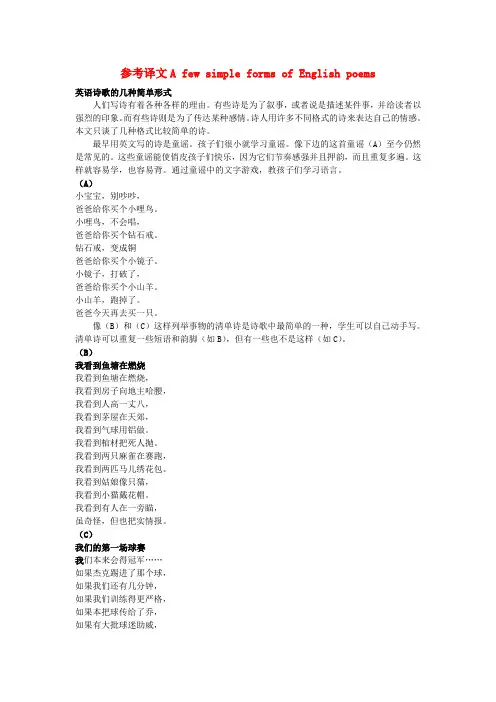
参考译文A few simple forms of English poems英语诗歌的几种简单形式人们写诗有着各种各样的理由。
有些诗是为了叙事,或者说是描述某件事,并给读者以强烈的印象。
而有些诗则是为了传达某种感情。
诗人用许多不同格式的诗来表达自己的情感。
本文只谈了几种格式比较简单的诗。
最早用英文写的诗是童谣。
孩子们很小就学习童谣。
像下边的这首童谣(A)至今仍然是常见的。
这些童谣能使俏皮孩子们快乐,因为它们节奏感强并且押韵,而且重复多遍。
这样就容易学,也容易背。
通过童谣中的文字游戏,教孩子们学习语言。
(A)小宝宝,别吵吵,爸爸给你买个小哩鸟。
小哩鸟,不会唱,爸爸给你买个钻石戒。
钻石戒,变成铜爸爸给你买个小镜子。
小镜子,打破了,爸爸给你买个小山羊。
小山羊,跑掉了。
爸爸今天再去买一只。
像(B)和(C)这样列举事物的清单诗是诗歌中最简单的一种,学生可以自己动手写。
清单诗可以重复一些短语和韵脚(如B),但有一些也不是这样(如C)。
(B)我看到鱼塘在燃烧我看到鱼塘在燃烧,我看到房子向地主哈腰,我看到人高一丈八,我看到茅屋在天郊,我看到气球用铝做。
我看到棺材把死人抛。
我看到两只麻雀在赛跑,我看到两匹马儿绣花包。
我看到姑娘像只猫,我看到小猫戴花帽。
我看到有人在一旁瞄,虽奇怪,但也把实情报。
(C)我们的第一场球赛我们本来会得冠军……如果杰克踢进了那个球,如果我们还有几分钟,如果我们训练得更严格,如果本把球传给了乔,如果有大批球迷助威,如果我死死盯住球,如果我们头晚不熬夜,如果我们没有太大意,如果我们没有精疲力竭,我们本来会得冠军……如果我们再干得好一些!另外,一种学生容易写的简体诗是由五行组成的,叫做五行诗。
用五行诗,学生可以用少量的词语传递一幅动人的画面。
请看下面的(D)和(E)两个例子。
(D)兄弟爱美,又爱运动爱闹,爱叫,又爱笑是我的朋友也是我的敌人(E)夏天困乏,刺激干涸,枯萎,恐怖周而复始永无止境俳句诗(Haiku)是一种日本诗,由17个音节组成。
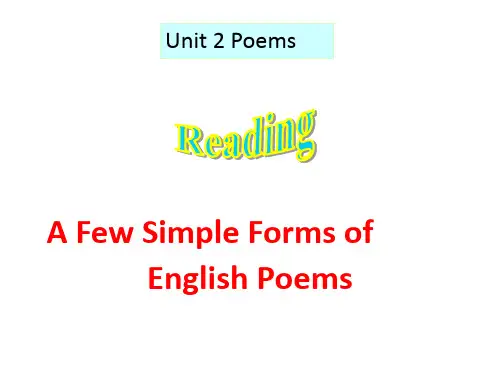
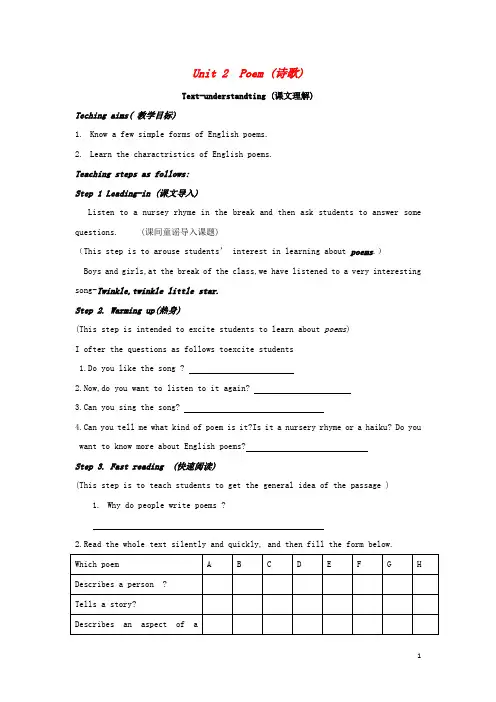
Unit 2 Poem (诗歌)Text-understandting (课文理解)Teching aims( 教学目标)1.Know a few simple forms of English poems.2.Learn the charactristics of English poems.Teaching steps as follows:Step 1 Leading-in (课文导入)Listen to a nursey rhyme in the break and then ask students to answer some questions. (课间童谣导入课题)(This step is to arouse students’ interest in learning about poems.)Boys and girls,at the break of the class,we have listened to a very interesting song-Twinkle,twinkle little star.Step 2. Warming up(热身)(This step is intended to excite students to learn about poems)I ofter the questions as follows toexcite students1.Do you like the song ?2.Now,do you want to listen to it again?3.Can you sing the song?4.Can you tell me what kind of poem is it?Is it a nursery rhyme or a haiku? Do you want to know more about English poems?Step 3. Fast reading (快速阅读)(This step is to teach students to get the general idea of the passage )1.Why do people write poems ?2.Read the whole text silently and quickly, and then fill the form below.Step 4Listening(听力)(This step is to train students’ listan ability .Explain to them that they should pay specisl attention to the key information)Five kinds of poems areand .Step5. Careful reading (细节阅读)(This step is to deal with prombles in detail )Task1.Answer the questions according to each poem1. Poem A1). What is the baby’s father going to buy if the mirror gets broken?2)What is the baby’s father going to do if goat runs away?2.Poem C1. )What sport do you think the speaker is writing about?2) Why didn’t the players win? Write down three excuses that the speaker gives3)Translate the following sentence into Chinesseif we hadn’t taken it easy,if we hadn’t run out of energy,we would have won3.Poem D,E1.) What subject is the speaker writing about?Poem D:PoemE: 2.) 2.) Does the speaker like the subject?Give a reason for your answerPoem D: Yes. Although the speaker describes a couple of negative aspects of his/ her brother, the reader can feel the affection that the speaker feels for his/ her brotherPoem E: No. The reader gets the feeling that the speaker can’t wait until the summer is over. The words drooping, dreading, week in week out and endless convey this feeling.4.Poem H1)What is the story that the poem tells? Tell the story in your own wordsA woman’s husband has gone away. The woman waits for him by the river where she last saw him. she waits and waits never moving form that spot and never speaking, while the river continues to flow and the wind and rain come and go.2)The woman may have the feelings of :loneliness: she was alone watching her husband on the mountain top.love: she waited year after year despite wind and rain.trust: she believed her husband would come back one day.sorrow: year after year, she waited and waited without seeing any hope of her husband’s coming back, she was very sad.Task 2. Fill in the chart as the examples given.Step 6 .Outline(提纲)(This step is to help students know the passage much more clearly) Outline: (课文行文顺序)1 the purpose of writing poems2.nursery rhyme3 list poems4 the cinquain5. the haiku6.Tang poemsStep 7. Consolidation(After the above reading, students can understand the text very well,so I arrange this step to consolidate what they have learned)Poems are used to tell a story or ________ certain emotions. Poets use many different ____________ of poems to ________________ themselves. For example, nursery rhymes _____________ small children because they have strong __________ and _______________and have a lot of _____________ , while, list poems is the _____________ kind of poems. Another simple form is the Cinquain ,____________ poem ________________ 5 lines. Haiku is a ______________ form of poetry that consists of 17___________________. In ________________,a lot of Tang poetry has also been ________________________ into English.Step 8.Discussion and performance(This step is helpful to strengthen the cooperation among students and use what they have learned. )1.Are poems good for our life?2 What can we get from poems?Poems bring passion (激情)to our lifePoems help us to understand life, virtues, beauty and romance.Poems make us know we are here and that we can make our life and the world more colorfuland beautiful!Step 9.Summary and Homework (小结及作业)1.Summary:In this period,we have learned much about English poems.Only if you havea good knowledge of poems can you understand English literature and culture.2.Homework:Write a composition according to the following poem阅读下面这首由英国诗人爱默生写的英语诗,然后用英语写一篇评价这首诗的短文: A Nation’s Strength 《民族的力量》Not gold,but only man can makeA people great and strong; 不是黄金,只有人才能使民族伟大而强盛;Men who for truth and honor’s sake为了真理,为了荣誉,Stand fast and suffer long. 他们意志坚定,历尽艰辛Brave men who work while others sleep, 他们无所畏惧,别人睡觉他们做工Who dare while others fly; 别人逃遁他们大显神勇;They build a nation’s pillar deep他们深深地埋下民族的支柱,And lift them to the sky. 并将石柱举起支撑天空。
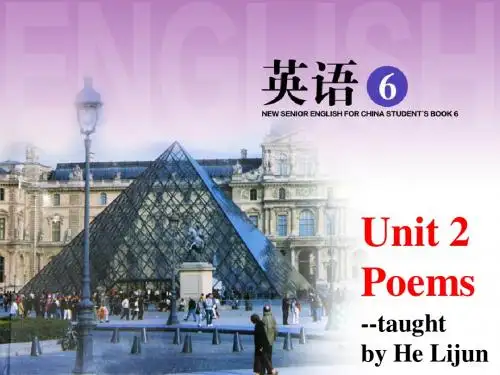
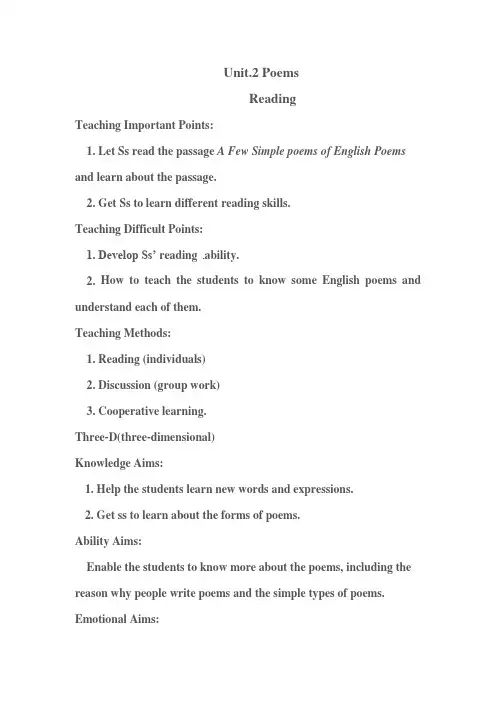
选修6 Unit 1 Art-ReadingA SHORT HISTORY OF WESTERN PAINTINGArt is influenced by the customs and faith of a people. Styles in Western art have changed many times. As there are so many different styles of Western art, it would be impossible to describe all of them in such a short text. Consequently, this text will describe only the most important ones, starting from the sixth century AD.The Middle Ages (5th to the 15th century AD)During the Middle Ages, the main aim of painters was to represent religious themes. A conventional artist of this period was not interested in showing nature and people as they really were. A typical picture at this time was full of religious symbols, which created feeling of respect and love for God. But it was evident that ideas were changing in the 13th century when painters like Giotto di Bondone began to paint religious scenes in a more realistic way.The Renaissance (15th to 16th century)During the Renaissance, new ideas and values graduallv replaced those held in the Middle Ages.People began to concentrate less on religious themes and adopt a more humanistic attitude to life. At the same time painters returned to classical Roman and Greek ideas about art. They tried to paint people and nature as they really were. Rich people wanted to possess t heir own paintings, so they could decorate their superb palaces and great houses. They paid famous artists to paint pictures of themselves, their houses and possessions as well as their activities and achievements.One of the most important discoveries during this period was how to draw things in perspective. This technique was first used by Masaccio in 1428. When people first saw his paintings, they were convinced that they were looking through a hole in a wall at a real scene. If the roles of perspective had not been discovered, no one would have been able to paint such realistic pictures. By coincidence, oil paints were also developed at this time, which made the colours used in paintings look richer and deeper. Without the new paints and the new technique, we would not be able to see the many great masterpieces for which this period is famous.Impressionism (late 19th to early 20th century)In the late 19th century, Europe changed a great deal. from a mostly agricultural society to a mostly industrial one. Many people moved from the countryside to the new cities. There were many new inventions and social changes. Naturally, these changes also led to new painting styles. Among the painters who broke away from the traditional style of painting were the Impressionists, who lived and worked in Paris.The Impressionists were the first painters to work outdoors. They were eager to show how light and shadow fell on objects at different times of day. However, because natural light changes so quickly, the Impressionists had to paint quickly. Their paintings were not as detailed as those of earlier painters. At first, many people disliked this style of painting and became very angr about it. They said that the painters were careless and their paintings were ridiculous.Modern Art (20th century to today)At the time they were created, the Impressionist paintings were controversial, but today they are accepted as the beginning of what we call "modem art". This is because t he Impressionists encouraged artists to look at their environment in new ways. There are scores of modern art styles, but without the Impressionists, many of these painting styles might not exist. On the one hand, some modem art is abstract; that is, the painter does not attempt to paint objects as we see them with our eyes, but instead concentrates on certain qualities of the object, using colour, line and shape to represent them. On the other hand, some paintings of modern art are so realistic that they look like photographs. These styles are so different. Who can predict what painting styles there will be in the future?THE BEST OF MANHATTAN’S ART GALLERIESThe Frick Collection (5th Avenue and E.70th Street)Many art lovers would rather visit this small art gallery than any other in New York. Henry Clay Frick, a rich New Yorker, died in 1919, leaving his house, furniture and art collection to the American people. Frick had a preference for pre-twentieth century Western paintings, and these are well-represented in this excellent collection. You can also explore Frick's beautiful home and garden which are well worth a Visit.Guggenheim Museum(5th Avenue and 88th Street)This museum owns 5,000 superb modern paintings, sculptures and drawings. These art works are not all displayed at the same time. The exhibition is always changing. It will appeal to those who love Impressionist and Post-Impressionist paintings. The Guggenheim Museum building is also world-famous. When you walk into gallery, you feel as if youwere inside a fragile, white seashell. The best way to see the paintings is to start from the top floor and walk down to the bottom. There are no stairs just a circular path. Themuseum also has an excellent restaurant.Metropolitan Museum of Art (5th Avenue and 82nd Street)The reputation of this museum lies in the variety of its art collection. This covers more than 5,000 years of civilization from many parts of the world, including America, Europe, China, Egypt, other African countries and South America. The museum displays more than just the visual delights of art. It introduces you to ancient ways of living. You can visit an Egyptian temple, a fragrant Ming garden, a typical room in an 18th century French house and many other special exhibitions.Museum of Modern Art (53rd Street, between 5th and 6th Avenues)It is amazing that so many great works of art from the late 19th century tothe 21st century are housed in the same museum. The collection of Western art includes paintings by such famous artists as Monet, Van Gogh, Picasso and Matisse. A few words of warning: the admission price is not cheap and the museum is often very crowded.Whitney Museum of American Art (945 Madison Avenue, near 75th Street)The Whitney holds an excellent collection of contemporary American painting and sculpture. There are no permanent displays in this museum and exhibitions change all the time. Every two years, the Whitney holds a special exhibition of new art by living artists. The museum also shows videos and films by contemporary video artists.选修6 Unit 2 Poems-ReadingA FEW SIMPLE FORMS OF ENGLISH POEMSThere are various reasons why people write poetry. Some poems tell a story or describe something in a way that will give the reader a strong impression. Otherstry to convey certain emotions. Poets use many different forms of poetry to express themselves. In this text, however, we will look at a few of the simpler forms.Some of the first poetry a young child learns in English is nursery rhymes. These rhymes like the one on the right (A) are still a common type of children's poetry. The language is concrete but imaginative, and they delight small children because they rhyme, have strong rhythm and a lot of repetition. The poems may not make sense and even seem contradictory, but they are easy to learn and recite. By playing with the words in nursery rhymes, children learn about language.A Hush, little baby, don't say a word, Papa's going to buy you a mockingbird. Ifthat mockingbird won't sing, Papa's going to buy you a diamond ring. If that diamond ring turns to brass, Papa's going to buy you a looking-glass. If that looking-glass gets broke, Papa's going to buy you a billy-goat. If that billy-goat runs away, Papa's going to buy you another today.One of the simplest kinds of poems are those like B and C that list things. List poems have a flexible line length and repeated phrases which give both a pattern and a rhythm to the poem. Some rhyme (like B) while others do not (like C).B I saw a fish-portal all on fireI saw a fish-pond all on fire,I saw a house bow to a squire,I saw a person twelve-feet high,I saw a cottage in the sky,I saw a balloon made of lead,I saw a coffin drop down dead,I saw two sparrows run a race,I saw two horses making lace,I saw g girl just like a cat,I saw a kitten wear a hat,I saw a man who saw these too,And said though strange they all were true.C Our first football matchWe would have won ...if Jack had scored that goal,if we'd had just a few more minutes,if we had trained harder,if Ben had passed the ball to Joe,if we'd had thousands of fans screaming,if I hadn't taken my eye off the ball,if we hadn't stayed up so late the night before,if we hadn't taken it easy,if we hadn't run out of energy.We would have won ...if we'd been better!Another simple form of poem that students can easily write is the cinquain, a poem made up of five lines. With these, students can convey a strong picture in just a few words. Look at the examples (D and E) on the top of the next page.D Brother Beautiful, athletic Teasing, shouting, laughing Friend and enemy too MineE Summer Sleepy, salty Drying, drooping, dreading Week in, week out EndlessF A fallen blossom Is coming back to the branch. Look, a butterfly!( byMoritake)G Snow having melted, The whole village is brimful Of happy children. (byIssa)Haiku is a Japanese form of poetry that is made up of 17 syllables. It is not a traditional form of English poetry, but is very popular with English writers. It is easyto write and, like the cinquain , can give a clear picture and create a special feeling using the minimum of words. The two haiku poems (F and G) above are translations from the Japanese.H Where she awaits her husband On and on the river flows. Never looking back,Transformed into stone.Day by day upon the mountain top,wind and rain revolve.Should the travellerreturn,this stone would utter speech.,(by Wang Jian)Did you know that English speakers also enjoy other forms of Asian poetry - Tang poems from China in particular? A lot of Tang poetry has been translated into English. This Tang poem (H) is a translation from the Chinese.With so many different forms of poetry to choose from, students may eventually want to write poems of their own. It is easier than you might think and certainly worth a try!I'VE SAVED THE SUMMERI've saved the summerAnd I give it all to youTo hold on winter morningsWhen the snow is new.I've saved some sunlightIf you should ever needA place away from darknessWhere your mind can feed.And for myself I've kept your smileWhen you were but nineteen,Till you're older you'll not knowWhat brave young smiles can mean.I know no answersTo help you on your wayThe answers lie somewhereAt the bottom of the day.But if you've a need for loveI'll give you all l ownIt might help you down the roadTill you've found your own.(by Rod McKuen)选修6 Unit 3 A healthy life-ReadingADVICE FROM GRANDADDear James,It is a beautiful day here and I am sitting under the big tree at the end of the garden. I have just returned from a long bike ride to an old castle. It seems amazing that at my age I am still fit enough to cycle 20 kilometres in an afternoon. It's my birthday in two weeks time and I'll be 82 years old! I think my long and active life must be due to the healthy life I live.This brings me to the real reason for my letter, my dear grandson. Your mother tells me that you started smoking some time ago and now you are finding it difficult to give it up. Believe me, I know how easy it is to begin smoking and how tough it is to stop. You see, during adolescence I also smoked and became addicted to cigarettes. By the way, did you know that this is because you become addicted in three different ways? First, you can become physically addicted to nicotine, which is one of the hundreds of chemicals in cigarettes. This means that after a while your body becomes accustomed to having nicotine in it. So when the drug leaves your body, you get withdrawal symptoms. I remember feeling bad-tempered and sometimes even in pain. Secondly, you become addicted through habit. As you know, if you do the same thing over and over again, you begin to do it automatically. Lastly, you can become mentally addicted. I believed I was happier and more relaxed after having a cigarette, so I began to think that I could only feel good when I smoked. I was addicted in all three ways, so it was very difficult to quit. But I did finally manage.When I was young, I didn't know much about the harmful effects of smoking. I didn't know, for example, that it could do terrible damage to your heart and lungs or that it was more difficult for smoking couples to become pregnant. I certainly didn't know their babies may have a smaller birth weight or even be abnormal in some way. Neither did I know that my cigarette smoke could affect the health of non-smokers. However, what I did know was that my girlfriend thought I smelt terrible. She said mybreath and clothes smelt, and that the ends of my fingers were turning yellow. She told me that she wouldn't go out with me again unless I stopped! I also noticed that I became breathless quickly, and that I wasn't enjoying sport as much. When I was taken off the school football team because I was unfit, I knew it was time to quit smoking.I am sending you some advice I found on the Internet. It might help you to stop and strengthen your resolve. I do hope so because I want you to live as long and healthy a life as I have.Love fromGrandadReading and discussingBefore you read the poster below, discuss what you know about HIV/AIDS with your classmates. Make a list of words that you might come across in this poster.HIV/AIDS:ARE YOU AT RISK?HIV is a virus. A virus is a very small living thing that causes disease. There are many different viruses, for example, the flu virus or the SARS virus. HIV weakens a person's immune system; that is, the part of the body that fights disease. You can have HIV in your blood for a long time, but eventually HIV will damage your immune system so much that you body can no longer fight disease. This stage of the illness is called AIDS. If you develop AIDS, your chances of survival are very small.HIV is spread through blood or the fluid that the body makes during sex. For a person to become infected, blood or sexual fluid that carries the virus, has to get inside the body through broken skin or by injection. One day scientists will find a cure for HIV/AIDS.Until that happens, you need to protect yourself. Here are some things you can do to make sure you stay safe.If you inject drugs:do not share your needle with anyone else. Blood from another person can stay on or in the needle. If a person has HIV and you use the same needle, you could inject the virus into your own blood.do not share anything else that a person has used while injecting drugs.Blood could have spilt on it.If you have sex with a male or a female:use a condom. This will prevent sexual fluid passing from one person to another.The following statements are NOT true.A person cannot get HIV the first time they have sex.WRONG. If one sexual partner has HIV, the other partner could become infected.You can tell by looking at someone whether or not they have HIV.WRONG. Many people carrying HIV look perfectly healthy. It is only when the disease has progressed to AIDS that a person begins to look sick.Only homosexuals get AIDS.WRONG. Anyone who has sex with a person infected with H1V/AIDS risks getting the virus. Women are slightly more likely to become infected than men.If you hug, touch or kiss someone with AIDS or visit them in their home, you will get HIV/AIDS.WRONG.You can only get the disease from blood or sexual fluid.Unfortunately, people with HIV sometimes lose their friends because of prejudice.Many people are afraid that they will get HIV/AIDS from those infected with HIV!AIDS. For the same reason, some AIDS patients cannot find anyone to look after them when they are sick.You can get HIV/AIDS from mosquitoes.WRONG. There is no evidence of this.选修6 Unit 4 Global warming-ReadingTHE EARTH IS BECOMING WARMER-BUT DOES IT MATTER?During the 20th century the temperature of the earth rose about one degree Fahrenheit. That probably does not seem much to you or me, but it is a rapid increase when compared to other natural changes. S o how has this come about and does it matter? Ea rth Care’s Sophie Armstrong explores these questions.There is no doubt that the earth is becoming warmer (see Graph 1) and that it is human activitythat has caused this global warming rather than a random but natural phenomenon.All scientists subscribe to the view that the increase in the earth's temperature is due to the burning of fossil fuels like coal, natural gas and oil to produce energy. Some byproducts of this process a re called "greenhouse" gases, t he most important one of which is carbon dioxide. Dr Janice Foster explains: "There is a natural phenomenon that scientists call the 'greenhouse effect'. This is when small amounts of gases in the atmosphere, like carbon dioxide, methane and water vapour, trap heat from the sun and therefore warm the earth. Without the 'greenhouse effect', the earth would be about thirty-three degrees Celsius cooler than it is. So, we need those gases. The problem begins when we add huge quantities of extra carbon dioxide into theatmosphere. I t means that more heat energy tends to be trapped in the atmosphere causing the global temperature to go up."We know that the levels of carbon dioxide have increased greatly over the last 100 to 150 years. It was a scientist called Charles Keeling, who made accurate measurements of the amount of carbon dioxide in the atmosphere from 1957 to 1997. He found that between these years the carbon dioxide in the atmosphere went up from around 315 parts to around 370 parts per million(see Graph 2).All scientists accept this data. They also agree that it is the burning of more and more fossilfuels that has resulted in this increase in carbon dioxide. So how high will the temperature increase go? Dr Janice Foster says that over the next 100 years the amount of warming could be as low as 1 to 1.5 degrees Celsius, but it could be as high as 5 degrees.However, the attitude of scientists towards this rise is completely different. On the one hand, Dr Foster thinks that the trend which increases t he temperature by 5 degrees would be a catastrophe. She says, "We can't predict the climate well enough to know what to expect, but it could be very serious." Others who agree with her think there may be a rise of several metres in the sea level, or predict severe storms, floods, droughts, famines, the spread of diseases a nd the disappearance o f species. On the other hand, there are those, like George Hambley, who are opposed to this view, believe that we should not worry about high levels of carbon dioxide in the air. They predict that any warming will be mild with few bad environmental consequences. In fact, Hambley states, "More carbon dioxide is actually a positive thing. It will make plants grow quicker; crops will produce more; it will encourage a greater range of animals - all of which will make life for human beings better."Greenhouse g ases continue to build up in the atmosphere. Even if we start reducing the amount of carbon dioxide and other greenhouse g ases, the climate is going to keep on warming for decades o r centuries. No one knows the effects of global warming. Does that mean we should do nothing? Or, are the risks too great?WHAT CAN WE DO ABOUT GLOBAL WARMING?Dear Earth Care,I am doing a project on behalf of my school about global warming. Sometimes I feel that individuals can have little effect on such huge environmental problems. However, 1 still think people should advocate improvements in the way we use energy today. As I'm not sure where to start with my project, I would appreciate any suggestions you may have.Thank you!OuyangGuangDear OuyangGuang,There are many people who have a commitment like yours, but they do not believe they have the power to do anything to improve our environment. That is not true. Together, individuals can make a difference. We do not have to put up with pollution. The growth of the greenhouse gas, carbon dioxide in the air actually comes as a result of many things we do every day. Here are a few suggestions on how to reduce it. They should get you started with your project.1 We use a lot of energy in our houses. It is OK to leave an electrical appliance on so long as you are using it - if not, turn it off! Do not be casual about this. So if you are not using the lights, the TV, the computer, and so on, turn them off. If you are cold, put on more clothes instead of turning up the heat.2 Motor vehicles use a lot of energy- so walk or ride a bike if you can.3 Recycle cans, bottles, plastic bags and newspapers if circumstances allow you to. It takes a lot of energy to make things from new materials, so, if you can, buy things made from recycled materials.4 Get your parents to buy things that are economical with energy - this includes cars as well as smaller things like fridges and microwaves.5 Plant trees in your garden or your school yard, as they absorb carbon dioxide from the air and refresh your spirit when you look at them.6 Finally and most importantly, be an educator. Talk with your family and friends about global warming and tell them what you have learned.Remember - your contribution counts!Earth Care选修6 Unit 5 The power of nature-ReadingAN EXCITING JOBI have the greatest job in the world. I travel to unusual places and work alongside people from all over the world. Sometimes working outdoors, sometimes inan office, sometimes using scientific equipment and sometimes meeting local people and tourists, I am never bored.Although my job is occasionally dangerous, I don't mind because danger excites me and makes me feel alive. However, the most important thing about my job is that I help protect ordinary people from one of the most powerful forces on earth - the volcano.I was appointed as a volcanologist working for the Hawaiian Volcano Observatory (HVO) twenty years ago. My job is collecting information for a database about Mount Kilauea, which is one of the most active volcanoes in Hawaii. Having collected and evaluated the information, I help other scientists to predict where lava from the volcano will flow next and how fast. Our work has saved many lives because people in the path of the lava can be warned to leave their houses. Unfortunately, we cannot move their homes out of the way, and many houses have been covered with lava or burned to the ground.When boiling rock erupts from a volcano and crashes back to earth, it causes less damage than you might imagine. This is because n o one lives near the top of Mount Kilauea, where the rocks fall. The lava that flows slowly like a wave down the mountain causes far more damage because it buries everything in its path under the molten rock. However, the eruption itself is really exciting to watch and I shall never forget my first sight of one. It was in the second week after I arrived in Hawaii. Having worked hard all day, I went to bed early. I was fast asleep when suddenly my bed began shaking and I heard a strange sound, like a railway train passing my window. Having experienced quite a few earthquakes in Hawaii already, I didn't take much notice. I was about to go back to sleep when suddenly my bedroom became as bright as day. I ran out of the house into the back garden where I could see Mount Kilauea in the distance. There had been an eruption from the side of the mountain and red hot lava was fountaining hundreds of metres into the air. It was an absolutely fantastic sight.The day after this eruption I was lucky enough to have a much closer look at it. Two other scientists and I were driven up the mountain and dropped as close as possible to the crater that had been formed during the eruption. Having earlier collected special clothes from the observatory, we put them on before we went any closer. All three of us looked like spacemen.We had white protective suits that covered our whole body, helmets, big boots and special gloves. It was not easy to walk in these suits, but we slowly made our way to the edge of the crater and looked down into the red, boiling centre. The other two climbed down into the crater to collect some lava for later study, but this being my first experience, I stayed at the top and watched them.Today, I am just as enthusiastic about my job as the day I first started. Having studied volcanoes now for many years, I am still amazed at their beauty as well as their potential to cause great damage.THE LRKE OF HERVENChangbaishan is in Jilin Province, Northeast China.Much of this beautiful, mountainous area is thick forest .Changbaishan is China's largest nature reserve and it is kept in its natural state for the people of China and visitors from all over the worldto enjoy. The height of the land varies from 700 metres above sea level to over 2,000 metres and is home to a great diversity of rare plants and animals. Among the rare animals are cranes, black bears, leopards and tigers. Many people come to Changbaishan t o study its unique plants and animals. Others come to walk in the mountains, to see the spectacular waterfalls or to bathe in the hot water pools. However, the attraction that arouses the greatest appreciation in the reserve is Tianchi or the Lake of Heaven.Tianchi is a deep lake that has formed in the crater of a dead volcano on top of the mountain. The lake is 2,194 metres above sea level, and more than 200 metres deep. In winter the surface freezes over. It takes about an hour to climb from the end of the road to the top of the mountain. When you arrive you are rewarded not only with the sight of its clear waters, but also by the view of the other sixteen mountain peaks that surround Tianchi.There are many stories told about Tianchi. The most well-known concerns three young women from heaven. They were bathing in Tainchi when a bird flew above them and dropped a small fruit onto the dress of the youngest girl. When she picked up the fruit to smell it, it flew into her mouth.Having swallowed the fruit, the girl became pregnant and later gave birth to a handsome boy. It is said that this boy, who had a great gift for languages and persuasion, is the father of the Manchu people.If you are lucky enough to visit the Lake of Heaven with your loved one, don't forget to drop a coin into the clear blue water to guarantee your love will be as deep and lasting as the lake itself.。
Unit 2 Poems Section Ⅰ Warming amp;Reading Pre-readingMeng Haoran (689 or 691-740, during the TangDynasty) was a major Tang Dynasty poet, and a somewhatolder contemporary of Wang Wei, Li Bai and Du Fu.He had a rather short civil service career, passing the JinshiCivil Service Test, beginning at the late age of 39 and ending notmuch later. He received his first and last position three yearsbefore his death, but resigned after less than a year. He lived inthe Xiangyang area almost all his life (although he traveled tothe major city of Chang'an, where he was entertained by WangWei in 728). The landscape, history and legends of his home areawere the subjects of many poems.Meng Haoran was a major influence on other contemporaryand following poets of the High Tang era because of his focuson nature as a main topic of poetry. Meng Haoran was also oneof the important poets in the Qing Dynasty poetry anthology(选集) the ThreeHundredTangPoems, having the fifth largestnumber of his poems included, for a total of fifteen, beaten onlyby Du Fu, Li Bai, Wang Wei, and Li Shangyin. The ThreeHundredTangPoems also has two poems by Li Bai addressedto Meng Haoran, one in his praise and one written in farewell(告别) o n the occasion of their parting company. Meng Haoranwas also influential in Japanese poetry.Section_ⅠWarming Up & Reading —Prereading [原文呈现][读文清障][课文翻译]A FEW SIMPLE FORMS OF ENGLISHPOEMSThere are various reasons why people write poetry①. Some poems tell a story or describe something in a way that will give the reader a strong impression②. Others try to convey③certain emotions④. Poets use many different forms of poetry to express themselves. In this text, however, we will look at a few of the simpler forms.Some of the first poetry a young child learns in English⑤is nursery rhymes⑥. These rhymes like the one on the right (A) are still a common type of children's poetry. The language is concrete ⑦but imaginative, and they delight small children because they rhyme, have strong rhythm and a lot of repetition⑧. The poems may not make sense and even seem contradictory⑨, but they are easy to learn and recite. By ①why引导定语从句,修饰先行词various reasons。